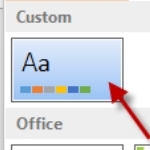
By Ellen Finkelstein
Create clear, iconic illustrations in PowerPoint
I’ve often recommended using photos instead of clip art (line art), but clip art can work well if you know how to choose and use it. In this post, I’ll explain how to choose clip art that won’t look silly and how to modify it to make your point clear.
When you choose line art, you usually want to find WMF images. WMF stands for Windows Metafile and it’s a vector format. This means that it’s defined as lines and curves, not as dots. On the other hand, some line art (and all photos) is in bitmap (also called raster) format, which means it’s made up of dots.
Bitmaps don’t resize well. You’ve probably had the experience of trying to make a photo larger and discovering that it looks fuzzy. On the other hand, WMFs, when you convert and ungroup them in PowerPoint, resize perfectly, never getting unclear.
How to choose modern-looking line art
So much of the clip art looks like it was created in the 1980′s — and perhaps it was. To find clip art that looks good these days, look for clean, simple lines. Try to find something iconic rather than sketchy.
How to use WMF clip art
The great feature of WMF images is that you can convert them to PowerPoint objects and ungroup them. Once you ungroup them, you can delete parts that you don’t want, change their color, and more. Let’s follow the process of choosing and using a piece of clip art. Suppose you want to talk about the need for your organization to grow and expand.
1. Choose Insert> Clip Art. In the Clip Art task pane, click the Results Should Be drop-down arrow and choose Illustrations. Uncheck all the other options.
2. Type tree in the Search For text box and press Enter or click the Go button. Lots of Christmas trees come up and if you don’t want to scroll through all of them, add -christmas to your search to remove them.

3. Hover your cursor over any image to see its specifications. You see the description of the image, who provided it, its size in pixels, the file size and the file format–see the red arrow at the right. You’re looking for WMF images. (Strange but true: You should be able to add WMF to your search terms to limit the results to WMF files, but when I did that, this tree didn’t appear!)
4. Choose this tree — it’s nice and simple. When you click it, it appears in the middle of the slide.
5. Right-click it and choose Group> Ungroup.

6. At the question asking you if you want to convert it to a drawing object, choose Yes, the default.
7. Usually, you need to ungroup the image a second time, so repeat the process. Now you see all of the components of the tree.
8. Usually, there’s a blank white box around the border of the image. Click the outermost rectangle and press the Delete key.
9. Delete the 3 wavy lines. Then delete the 3 green fills. You’ll be left with an image like this. Do you see how clean and clear it looks?

This post is excerpted with the permission of PowerPoint Tips.




